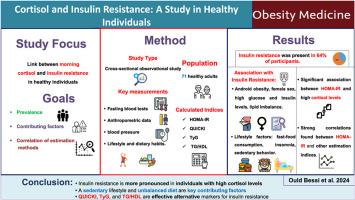Association between 8 a.m. cortisol levels and insulin resistance in healthy individuals from Algiers
Q2 Medicine
引用次数: 0
Abstract
Background
Cortisol is a counterregulatory hormone that antagonizes insulin. Its chronic supraphysiological elevation induces insulin resistance, a risk factor for cardiovascular and metabolic diseases. However, the relationship between insulin resistance and normal cortisol concentrations remains controversial. This study evaluates the association between 8:00 a.m. cortisol levels and insulin resistance, as estimated by the HOMA-IR index, and compares the HOMA-IR index with other insulin resistance indices: QUICKI, TyG, and the TG/HDL ratio.
Methods
Healthy adult volunteers were recruited. Exclusion criteria included smoking, pregnancy, and use of lipid-lowering medications, steroids, antidiabetic agents, or antihypertensive agents. Fasting measurements included blood glucose, insulin, cortisol, C-peptide, triglycerides, total cholesterol, LDL cholesterol, HDL cholesterol, and AST. Blood pressure was measured, and a questionnaire on clinical, anthropometric, dietary, and lifestyle data was completed.
Results
Of 77 participants, 6 were excluded due to impaired biochemical status. A significant association was found between the HOMA-IR index and cortisol levels in the upper normative range (≥95.5 μg/L, p < 0.001). This association was also found with BMI, waist circumference, insomnia, sedentary lifestyle, unbalanced diet, and fruit intake, but not for sweets and vegetable intake (p > 0.05). A correlation was confirmed between insulin resistance (assessed by the HOMA-IR index) and other indices such as QUICKI, the TG/HDL ratio and the TyG index.
Conclusion
The QUICKI, TyG and TG/HDL indices are good alternative indicators of insulin resistance, which is more severe in people with cortisol levels in the upper normative range. In addition, a sedentary lifestyle and unbalanced diet also contribute to insulin resistance.

阿尔及尔健康人早上8点皮质醇水平与胰岛素抵抗之间的关系
皮质醇是一种对抗胰岛素的反调节激素。它的慢性生理上升高导致胰岛素抵抗,这是心血管和代谢疾病的危险因素。然而,胰岛素抵抗和正常皮质醇浓度之间的关系仍然存在争议。本研究通过HOMA-IR指数评估上午8:00皮质醇水平与胰岛素抵抗之间的关系,并将HOMA-IR指数与其他胰岛素抵抗指数(QUICKI、TyG和TG/HDL比值)进行比较。方法招募健康成人志愿者。排除标准包括吸烟、怀孕、使用降脂药物、类固醇、抗糖尿病药物或抗高血压药物。空腹测量包括血糖、胰岛素、皮质醇、c肽、甘油三酯、总胆固醇、低密度脂蛋白胆固醇、高密度脂蛋白胆固醇和谷草转氨酶,测量血压,完成临床、人体测量、饮食和生活方式数据的问卷调查。结果77例受试者中,6例因生化状态受损而被排除。HOMA-IR指数与皮质醇水平在规范上限(≥95.5 μg/L, p < 0.001)之间存在显著相关性。体重指数、腰围、失眠、久坐不动的生活方式、不平衡的饮食和水果摄入量也存在这种关联,但与甜食和蔬菜摄入量无关(p > 0.05)。胰岛素抵抗(由HOMA-IR指数评估)与其他指标如QUICKI、TG/HDL比值和TyG指数之间存在相关性。结论QUICKI、TyG和TG/HDL指标是胰岛素抵抗的较好替代指标,皮质醇水平在正常值较高的人群胰岛素抵抗更为严重。此外,久坐不动的生活方式和不平衡的饮食也会导致胰岛素抵抗。
本文章由计算机程序翻译,如有差异,请以英文原文为准。
求助全文
约1分钟内获得全文
求助全文
来源期刊

Obesity Medicine
Medicine-Public Health, Environmental and Occupational Health
CiteScore
5.50
自引率
0.00%
发文量
74
审稿时长
40 days
期刊介绍:
The official journal of the Shanghai Diabetes Institute Obesity is a disease of increasing global prevalence with serious effects on both the individual and society. Obesity Medicine focusses on health and disease, relating to the very broad spectrum of research in and impacting on humans. It is an interdisciplinary journal that addresses mechanisms of disease, epidemiology and co-morbidities. Obesity Medicine encompasses medical, societal, socioeconomic as well as preventive aspects of obesity and is aimed at researchers, practitioners and educators alike.
 求助内容:
求助内容: 应助结果提醒方式:
应助结果提醒方式:


